H. Bannister Itinerary, July 13, 1932, Newspaper Unknown (Source: Woodling)
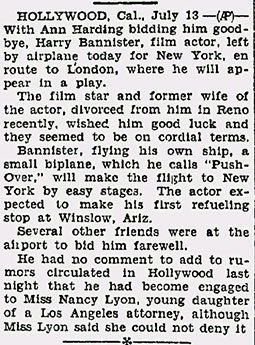 |
Harry C. Bannister landed at the Davis-Monthan Airfield
solo sometime between July 11 and 18, 1932 (he didn't enter the exact date, but the date can be refined from the article, right). He
was flying Travel Air NC24274, apparently solo. He was eastbound from
Los Angeles,
CA to New York.
The article at right places Bannister flying his airplane east, but it does not suggest a reason for his voyage. Neither does the article place him in Tucson, but chances are good that he flew south to Tucson, because heading straight east from his first fuel stop at Winslow, AZ would take him into some pretty high mountains between Winslow and Albuquerque, NM. It would have been more prudent to turn south through Tucson, after which it is a simple, low-altitude flight east. Regardless of the rumor regarding Nancy Lyon, he did not marry her. His relationship with Ann Harding is discussed below.
Bannister was born September 29, 1889 (I've seen 1890, as well) in
Holland, MI, and flew West February 26, 1961
in New York. He was a screen, stage and television producer, director and performer. His
work is summarized on
the Internet Broadway Database.
The 1900 U.S. Census placed him at age 10 living in Shelby, MI with his widowed mother and older sister, Mina (14). He continued living with his mother at age 20 in Flint, MI in the 1910 Census. Interestingly, his occupation was listed as "Stenographer" for an auto parts company.
In 1920 at age 31, the Census placed him living in a large, coed boarding house (he had 41 housemates) or hotel at 15 Grand Avenue in Oklahoma City, OK. His occupation was coded as theatrical actor. Many of his housemates were actors or dancers, including one 28-year-old vaudeville performer, Viola Goyette. As interesting as her name sounded, I found no information about her.
Bannister was married October 21, 1926 to performer Ann Harding (b.
August 7, 1901 in Fort Sam Houston, TX; d. September 1, 1981
in Sherman Oaks, CA). Her
work is summarized here.
They had one daughter, Jane (one source says Phoebe). Photograph, left, is from the Newark Star-Eagle, Tuesday May
5, 1931.
The photo, above left, shows the couple in Los Angeles. The picture caption
states they have just completed a 4,000 mile air tour started
from New York (although they didn't look any the worse for
wear). The airplane cowl in the original news article
showed the classy machine work finish, which is difficult to
see in this cropped shot.
The 1930 Census placed Bannister (age 40) married and living with his wife, Ann (27) at 14412 Greenleaf Street, Los Angeles, CA. On Google Earth today this address is a large red brick, two-storey home with a turret and red tile roof. They rented their home for $300 per month. Their daughter, Jane (1; 1928-2005) lived with them, as did Ruby Miller (27) their cook, and Anna Arbuckle (42) Jane's nurse. Bannister's and Ann's occupations were coded as "Actor" in "Motion Pictures."
The New York Times, March 24, 1932 (Source: NYT)
 |
In 1931, the couple was documented during international travel from Agua Caliente, Mexico on the following U.S. Immigration form. Their airplane, NC127W, was a Northrop Alpha operated by T.W.A. out of the Grand Central Air Terminal in Glendale, CA. Please direct your browser to the airplane's link to view photographs of this robust and fast Golden age airliner. Leland (Lee) Miles was probably the pilot. Interestingly, Miles was logged in the Oxnard Field Register, Albuquerque, NM four times between 1931 and 1936. He was flying airplanes that belonged to Ann Harding. Agua Caliente was a popular destination for Americans who traveled south of the border to drink alcohol during Prohibition (1920-1933).
U.S. Immigration Form, January 4, 1931 (Source: ancestry.com)
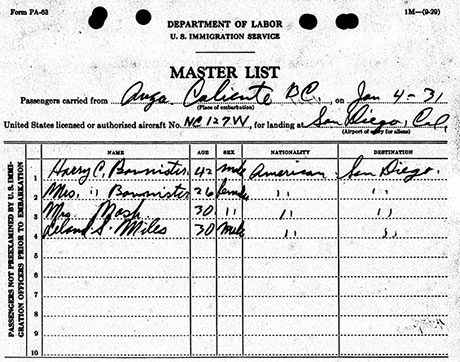 |
Two additional Immigration forms documented Bannister's travel to and from Agua Caliente on November 30 and December 7, 1930 aboard NC933W, a Stinson SM-7B owned by Erret Lobban Cord, principal in the Auburn-Cord Automobile Company. Bannister's passengers included his wife, Ann Harding, Nash and Miles, same as above. I found no relationship between Cord and Bannister, or between Cord and Miles or Harding. I do not know why they would be flying Cord's airplane from Mexico to San Diego. Interestingly, Cord flew this airplane to a landing at Albuquerque, NM just a month earlier on November 10, 1930. He noted in that Register that he was flying eastbound from Winslow, AZ to Auburn, IN. This means the airplane was flown back to California sometime between the 10th and the 30th of November. There was no record of that flight, or any other flight by 933W, in any Register.
Deadwood Pioneer-Times (SD), March 31, 1932 (Source: newspapers.com)
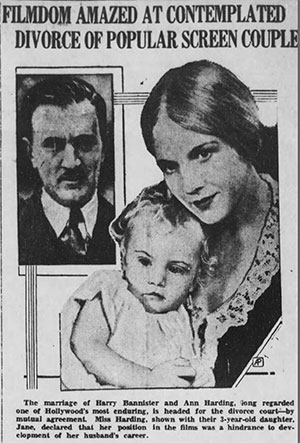 |
Sadly, a few months before he landed at Tucson during 1932, the Bannisters agreed to divorce, because of a seeming lack of ego by both parties. Their intention to divorce was reported in The New York Times (NYT), March 24, 1932, above, right, as well as local California papers. The news made it to Deadwood, SD, left. This was highly irregular news, because they were considered one of Hollywood's most stable dream couples.
Montana Standard, March 25, 1932 (Source: newspapers.com)
 |
That their pending divorce was a shock to the Hollywood community was made clear in the Montana Standard, March 25, 1932, right.
Indeed, before and after their divorce, the couple was the subject of numerous Hollywood gossip columnists. About a year after they separated, the Nebraska State Journal (Lincoln), July 23, 1933 published a very long and intelligent article that analyzed the formations and breakups of numerous contemporary Hollywood marriages, including those of Dolores del Rio, Carol Lombard and William Powell, and the Fairbanks, both Sr. & Jr. If you are of an age that these names are unfamiliar to you, simply link over to meet them. They were significant cultural forces in the mid-20th century.
For many Hollywood couples, the overshadowing of one spouse's career versus the other was a common, though shallow, cause of divorce. So, too, was the saga of the casting couch and its effects on marital bliss, which, in 1932, was just as active in Hollywood and elsewhere as in 2017 as I write this revision. Regardless, I left the filler at the end of the article at right about the columnist's conversation with Harpo Marx. Compare the list at the link with Harpo's list at right.
Their divorce was finalized in Reno, NV on May 5, 1932 and reported in The New York Times of the same date. According to the Times, they parted with a kiss, remaining mutually respectful, and, allegedly, still in love. That was not to last.
She returned to Los Angeles. He said he was in the midst of considering several "attractive" offers to appear in films. The Times stated, "He will leave here tomorrow for Hollywood and then go to New York to interview various producers."
Besides getting him to New York and thence to London, Bannister's flight through Tucson in July 1932, a long, cross-country solo flight, probably did wonders to clear his post-divorce state of mind.
Upon return from London, in New York, he founded the American Music Hall on East 55th Street. As a result of his work there, The New York Times, February 1, 1936, announced the staging of "The Murder in the Old Red Barn." Brooks Atkinson of the New York Times reviewed the American production February 3, 1936. His surreal review is below.
The New York Times. February 3, 1936 (Source: NYT)
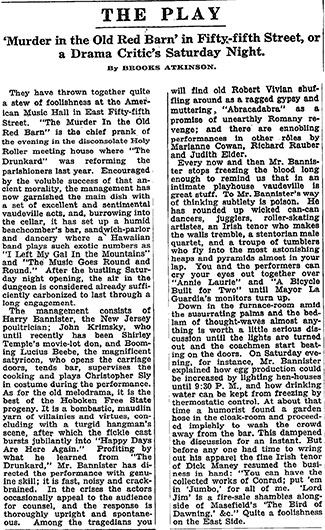 |
Almost simultaneous with Bannister's opening at the American Music Hall, Harding sailed to England for a filming assignment and took young Jane. The circumstances of her voyage were suspect and, long story short, Bannister put out a warrant for her, charging her with the abduction of their daughter. She paid little attention to the warrant, claiming she had permission for the child to travel with her, as reported below on June 1, 1936. Another article in The New York Times of June 7th stated her intention to return to the United States in December that year.
The Wilkes-Barre Record (PA), June 1, 1936 (Source: newspapers.com)
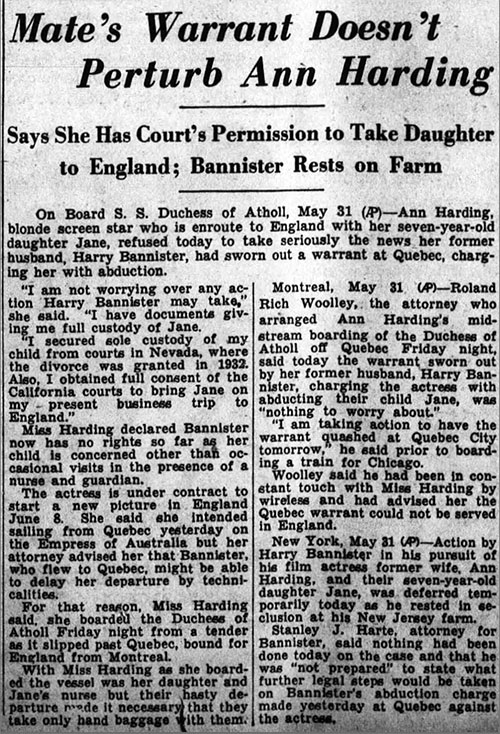 |
She did not return to Hollywood until 1943. Rather, she met and married Werner Janssen in early 1937. Their intention to wed was reported in The New York Times, January 16, 1937, below left. They divorced in 1963 and they had one daughter. Bannister also remarried in 1936 to Leah Moskowitz Welt. They had one daughter together, Phoebe.
The 1940 Census listed them (Bannister was 48, Leah was 42) living at 120 East 22 Street, New York (rented apartment, $90 per month). Both were in theater production, earning less than $5,000 per year. Phoebe was two years old. Bannister and Leah remained married until Bannister's death, February 26, 1961. His obituary is below, right.
The New York Times, January 16, 1937 (Source: NYT)
 |
Harry C. Bannister Obituary, The New York Times, February 27, 1961 (Source: NYT)
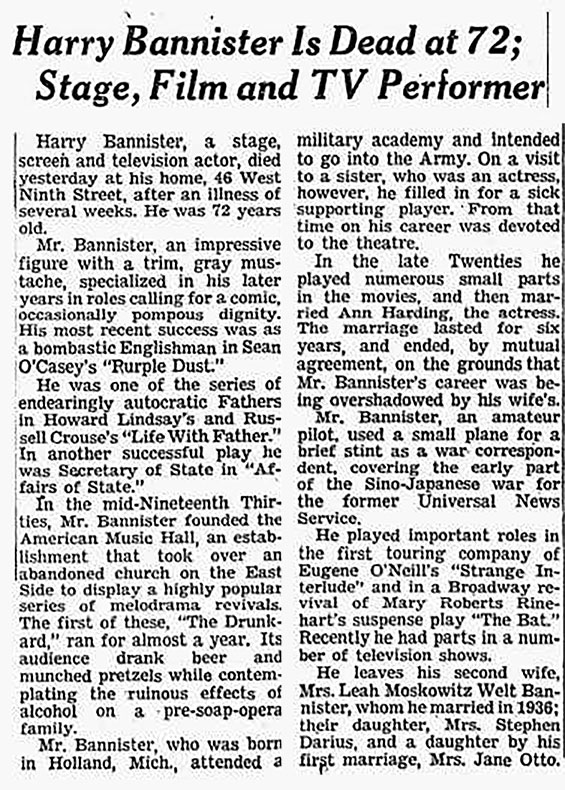 |
Ann Harding passed away September 1, 1981. Her obituary from The New York Times, September 4, 1981 appeared as follows.
ANN HARDING, ACTRESS HAILED FOR ROLES AS ELEGANT WOMEN
By Carol Lawson, September 4, 1981
Ann Harding, who was known for her stage and screen portrayals of beautiful, aristocratic women in the 1920's and 30's, died Tuesday at her home in Sherman Oaks, Calif., after a long illness. She was 79 years old.
Miss Harding made her Broadway debut in 1921 in ''Like a King.'' In his review in The New York Times, Alexander Woollcott complimented the producer for ''selecting the comely and interesting'' young actress for the play. Miss Harding's first major success came two years later in the hit show ''Tarnish.''
A petite woman with a patrician face and long blond hair tied in a bun at the nape of her neck, the actress appeared in 10 plays on Broadway during the 20's, including ''Thoroughbreds,'' ''Stolen Fruit,'' ''A Woman Disputed'' and ''Taming of the Shrew.''
A Hit in 'Mary Dugan' She had her second big success in 1927 as the title character in ''The Trial of Mary Dugan.'' She played the role 437 times in New York and then toured in it.
In 1929, Miss Harding left New York for Hollywood to embark on a film career. She made ''about 40'' pictures, by her own count. Because of her stage experience, she was much in demand in the early days of talking pictures when there was a scarcity of beautiful actresses in Hollywood who knew how to deliver a line.
Miss Harding made her film debut in the 1929 picture ''Paris Bound.'' Later that year she starred opposite Ronald Colman in ''Comdemned.'' She continued to make one film after another for the next several years, including the first movie version of Philip Barry's ''Holiday,'' in 1930; ''The Girl of the Golden West,'' ''East Lynne,'' ''The Animal Kingdom'' with Leslie Howard,'' ''When Ladies Meet'' with Joan Crawford and Robert Montgomery, ''Biography of a Bachelor Girl,'' based on S.N. Behrman's play ''Biography''; ''Peter Ibbetson'' with Gary Cooper and ''Love From a Stranger.''
Left Screen in 1936 In 1936, Miss Harding retired from the screen after a bitter court fight with her former husband, the actor Harry Bannister, over custody of their daughter, Jane, who was born in 1929 . She and Mr. Bannister had married in 1926 and divorced in 1932.
Later, Miss Harding, who had been under contract to RKO Pathe Studio, did not speak of Hollywood in flattering terms. ''I loathed the stupidity in the handling of the material in Hollywood,'' she remarked. Nor did she like the studio system. ''If you're under contract when you're making pictures you may get the plums, but they own your soul,'' she said. ''If you're not under contract, you have to take your chances.''
In 1937, she married Werner Janssen, the symphony conductor. Miss Harding returned to Hollywood in 1943 when Mr. Janssen's work took him there. She made two films that year, ''Mission to Moscow'' and ''North Star.'' She and Mr. Janssen were divorced in 1962.
Known for Supporting Roles Later in her film career, Miss Harding was known for her supporting roles as wives and mothers. In 1951 she appeared as the gracious Mrs. Oliver Wendell Holmes, opposite Louis Calhern, in ''The Magnificent Yankee.'' In 1956, she played Fredric March's wife in ''The Man in the Gray Flannel Suit.''
Miss Harding returned to Broadway in 1949 to take over the leading role in the comedy hit ''Goodbye, My Fancy.'' In 1962 she appeared in the short-lived ''General Seeger,'' starring George C. Scott, and in 1964 she was seen briefly in ''Abraham Cochrane.''
The daughter of the late Gen. Grant C. Gately, Miss Harding was born Anna Gately at Fort Sam Houston in San Antonio, Tex., on Aug. 17, 1902. She grew up on Army posts around the country and in Havana. ''Before I was 13 years old I had attended 13 different schools,'' the actress once said. She studied drama with Otis Skinner at the Baldwin School in Bryn Mawr, Pa., where she appeared as Macduff in a production of ''Macbeth'' that featured Cornelia Otis Skinner as Lady Macbeth.
Was a Script Reader At first, Miss Harding supported herself as a clerk for an insurance company while moonlighting as a reader for the Famous-Players-Lasky film company. Her first professional appearance was in ''Inheritors'' with the Provincetown Players.
Besides the stage and screen, Miss Harding also appeared on television. She starred with Dorothy Gish and Beulah Bondi in a 1960 television adaptation of Paul Osborn's play ''Morning's at Seven,'' and was also seen on the ''Ben Casey'' and ''The Defenders'' series.
Miss Harding is survived by her daughter, Jane Otto, and four grandchildren. |
Dossier 2.1.40
---o0o---
UPLOADED: 03/04/06 REVISED: 12/19/17
|











